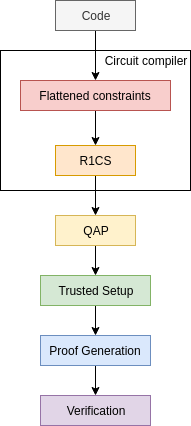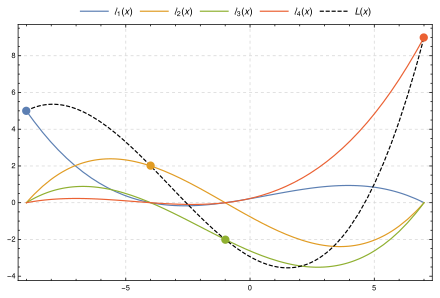23 KiB
zkSNARKs from scratch, a technical explanation

iden3.io
github.com/iden3
twitter.com/identhree
Warning
-
I'm not a mathematician, this talk is not for mathematicians
-
In free time, have been studying zkSNARKS & implementing it in Go
-
Talk about a technical explaination from an engineer point of view
-
The idea is to try to transmit the learnings from long night study hours during last winter
-
Also at the end will briefly overview how we use zkSNARKs in iden3
-
This slides will be combined with
- parts of the code from https://github.com/arnaucube/go-snark
- whiteboard draws and writtings
-
Don't use your own crypto. But it's fun to implement it (only for learning purposes)
Contents
- Introduction
- zkSNARK overview
- zkSNARK flow
- Generating and verifying proofs
- Foundations
- Basics of modular arithmetic
- Groups
- Finite fields
- Elliptic curve operations
- Pairings
- Bilinear Pairings
- BLS signatures
- zkSNARK (Pinocchio)
- Circuit compiler
- R1CS
- QAP
- Lagrange Interpolation
- Trusted Setup
- Proofs generation
- Proofs verification
- Groth16
- How we use zkSNARKs in iden3
- libraries
- Circuit languages
- utilities (Elliptic curve & Hash functions) inside the zkSNARK libraries
- BabyJubJub
- Mimc
- Poseidon
- References
Introduction
- zero knowledge concept
- examples
- some concept explanations
zkSNARK overview
- protocol to prove the correctness of a computation
- useful for
- scalability
- privacy
- interoperability
- examples:
- Alice can prove to Brenna that knows $x$ such as $f(x) = y$
- Brenna can prove to Alice that knows a certain input which $Hash$ results in a certain known value
- Carol can proof that is a member of an organization without revealing their identity
- etc
zkSNARK flow

Generating and verifying proofs
Generating a proof:


Verifying a proof:

Foundations
- Modular aritmetic
- Groups
- Finite fields
- Elliptic Curve Cryptography
Basics of modular arithmetic
- Modulus,
mod,% - Remainder after division of two numbers
5 mod 12 = 5
14 mod 12 = 2
83 mod 10 = 3
5 + 3 mod 6 = 8 mod 6 = 2
Groups
- a set with an operation
- operation must be associative
- neutral element ($identity$): adding the neutral element to any element gives the element
- inverse: $e$ + $e_{inverse}$ = $identity$
- cyclic groups
- finite group with a generator element
- any element must be writable by a multiple of the generator element
- abelian group
- group with commutative operation
Finite fields
- algebraic structure like Groups, but with two operations
- extended fields concept (https://en.wikipedia.org/wiki/Field_extension)
Elliptic curve
- point addition
$(x_1, y_1) + (x_2, y_2) = (\dfrac{ x_1 y_2 + x_2 y_1 }{ 1 + d x_1 x_2 y_1 y_2 }, \dfrac{ y_1 y_2 - x_1 x_2 }{ 1-dx_1 x_2 y_1 y_2 })$
- G1
- G2
(whiteboard explanation)
Pairings
- 3 typical types used for SNARKS:
- BN (Barreto Naehrig) - used in Ethereum
- BLS (Barreto Lynn Scott) - used in ZCash & Ethereum 2.0
- MNT (Miyaji- Nakabayashi - Takano) - used in CodaProtocol
- $y^2 = x^3 + b$ with embedding degree 12
- function that maps (pairs) two points from sets
S1andS2into another setS3 - is a bilinear function
- $e(G_1, G_2) -> G_T$
- the groups must be
- cyclic
- same prime order ($r$)
- $F_q$, where $q=$
21888242871839275222246405745257275088696311157297823662689037894645226208583 - $F_r$, where $r=$
21888242871839275222246405745257275088548364400416034343698204186575808495617
Bilinear Pairings
$e(P_1 + P_2, Q_1) == e(P_1, Q_1) \cdot e(P_2, Q_1)$
$e(P_1, Q_1 + Q_2) == e(P_1, Q_1) \cdot e(P_1, Q_2)$
$e(aP, bQ) == e(P, Q)^{ab} == e(bP, aQ)$

$e(g_1, g_2)^6 == e(g_1, 6 \cdot g_2)$
$e(g_1, g_2)^6 == e(6 \cdot g_1, g_2)$
$e(g_1, g_2)^6 == e(3 \cdot g_1, 2 g_2)$
$e(g_1, g_2)^6 == e(2 \cdot g_1, 3 g_2)$
BLS signatures
(small overview, is offtopic here, but is interesting)
- key generation
- random private key $x$ in $[0, r-1]$
- public key $g^x$
- signature
- $h=Hash(m)$ (over G2)
- signature $\sigma=h^x$
- verification
- check that: $e(g, \sigma) == e(g^x, Hash(m))$ $e(g, h^x) == e(g^x, h)$
- aggregate signatures
- $s = s0 + s1 + s2 ...$
- verify aggregated signatures
$e(G,S) == e(P, H(m))$
$e(G, s0+s1+s2...) == e(p0, H(m)) \cdot e(p1, H(m)) \cdot e(p2, H(m)) ...$
More info: https://crypto.stanford.edu/~dabo/pubs/papers/BLSmultisig.html
Circuit compiler
-
not a software compiler -> a constraint prover
- what this means
-
constraint concept
value0==value1<operation>value2
-
want to proof that a certain computation has been done correctly
-
graphic of circuit with gates (whiteboard)
-
about high level programing languages for zkSNARKS, by Harry Roberts: https://www.youtube.com/watch?v=nKrBJo3E3FY
Circuit code example: $f(x) = x^5 + 2\cdot x + 6$
func exp5(private a):
b = a * a
c = a * b
d = a * c
e = a * d
return e
func main(private s0, public s1):
s2 = exp5(s0)
s3 = s0 * 2
s4 = s3 + s2
s5 = s4 + 6
equals(s1, s5)
out = 1 * 1
Inputs and Witness
For a certain circuit, with the inputs that we calculate the Witness for the circuit signals
- private inputs:
[8]- in this case the private input is the 'secret' $x$ value that computed into the equation gives the expected $f(x)$
- public inputs:
[32790]- in this case the public input is the result of the equation
- signals:
[one s1 s0 b0 c0 d0 s2 s3 s4 s5 out] - witness:
[1 32790 8 64 512 4096 32768 16 32784 32790 1]
R1CS
- Rank 1 Constraint System
- way to write down the constraints by 3 linear combinations
- 1 constraint per operation
- $(A, B, C) = A.s \cdot B.s - C.s = 0$
- from flat code constraints we can generate the R1CS
R1CS
$(a_{11}s_1 + a_{12}s_2 + ... + a_{1n}s_n) \cdot (b_{11}s_1 + b_{12}s_2 + ... + b_{1n}s_n) - (c_{11}s_1 + c_{12}s_2 + ... + c_{1n}s_n) = 0$
$(a_{21}s_1 + a_{22}s_2 + ... + a_{2n}s_n) \cdot (b_{21}s_1 + b_{22}s_2 + ... + b_{2n}s_n) - (c_{21}s_1 + c_{22}s_2 + ... + c_{2n}s_n) = 0$ $(a_{31}s_1 + a_{32}s_2 + ... + a_{3n}s_n) \cdot (b_{31}s_1 + b_{32}s_2 + ... + b_{3n}s_n) - (c_{31}s_1 + c_{32}s_2 + ... + c_{3n}s_n) = 0$ [...] $(a_{m1}s_1 + a_{m2}s_2 + ... + a_{mn}s_n) \cdot (b_{m1}s_1 + b_{m2}s_2 + ... + b_{mn}s_n) - (c_{m1}s_1 + c_{m2}s_2 + ... + c_{mn}s_n) = 0$
*where $s$ are the signals of the circuit, and we need to find $a, b, c$ that satisfies the equations
R1CS constraint example:
- signals:
[one s1 s0 b0 c0 d0 s2 s3 s4 s5 out] - witness:
[1 32790 8 64 512 4096 32768 16 32784 32790 1] - First constraint flat code:
b0 == s0 * s0 - R1CS first constraint: $A_1 = [00100000000]$ $B_1 = [00100000000]$ $C_1 = [00010000000]$
R1CS example:
| $A$ | $B$ | $C$: |
|---|---|---|
| $[0 0 1 0 0 0 0 0 0 0 0]$ $[0 0 1 0 0 0 0 0 0 0 0]$ $[0 0 1 0 0 0 0 0 0 0 0]$ $[0 0 1 0 0 0 0 0 0 0 0]$ $[0 0 1 0 0 0 0 0 0 0 0]$ $[0 0 0 0 0 0 1 1 0 0 0]$ $[6 0 0 0 0 0 0 0 1 0 0]$ $[0 0 0 0 0 0 0 0 0 1 0]$ $[0 1 0 0 0 0 0 0 0 0 0]$ $[1 0 0 0 0 0 0 0 0 0 0]$ |
$[0 0 1 0 0 0 0 0 0 0 0]$ $[0 0 0 1 0 0 0 0 0 0 0]$ $[0 0 0 0 1 0 0 0 0 0 0]$ $[0 0 0 0 0 1 0 0 0 0 0]$ $[2 0 0 0 0 0 0 0 0 0 0]$ $[1 0 0 0 0 0 0 0 0 0 0]$ $[1 0 0 0 0 0 0 0 0 0 0]$ $[1 0 0 0 0 0 0 0 0 0 0]$ $[1 0 0 0 0 0 0 0 0 0 0]$ $[1 0 0 0 0 0 0 0 0 0 0]$ |
$[0 0 0 1 0 0 0 0 0 0 0]$ $[0 0 0 0 1 0 0 0 0 0 0]$ $[0 0 0 0 0 1 0 0 0 0 0]$ $[0 0 0 0 0 0 1 0 0 0 0]$ $[0 0 0 0 0 0 0 1 0 0 0]$ $[0 0 0 0 0 0 0 0 1 0 0]$ $[0 0 0 0 0 0 0 0 0 1 0]$ $[0 1 0 0 0 0 0 0 0 0 0]$ $[0 0 0 0 0 0 0 0 0 1 0]$ $[0 0 0 0 0 0 0 0 0 0 1]$ |
QAP
- Quadratic Arithmetic Programs
- 3 polynomials, linear combinations of R1CS
- very good article about QAP by Vitalik Buterin https://medium.com/@VitalikButerin/quadratic-arithmetic-programs-from-zero-to-hero-f6d558cea649
Lagrange Interpolation
(Polynomial Interpolation)
- for a group of points, we can find the smallest degree polynomial that goees through all that points
- this polynomial is unique for each group of points
$L(x) = \sum_{j=0}^{n} y_j l_j(x)$
Shamir's Secret Sharing
(small overview, is offtopic here, but is interesting)
- from a secret to be shared, we generate 5 parts, but we can specify a number of parts that are needed to recover the secret
- so for example, we generate 5 parts, where we will need only 3 of that 5 parts to recover the secret, and the order doesn't matter
- we have the ability to define the thresholds of $M$ parts to be created, and $N$ parts to be able the recover
Shamir's Secret Sharing - Secret generation
- we want that are necessary $n$ parts of $m$ to recover $s$
- where $n<m$
- need to create a polynomial of degree $n-1$ $f(x) = \alpha_0 + \alpha_1 x + \alpha_2 x^2 + \alpha_3 x^3 + ... + + \alpha_{n-1} x^{n-1}$
- where $\alpha_0$ is the secret $s$
- $\alpha_i$ are random values that build the polynomial *where $\alpha_0$ is the secret to share, and $\alpha_i$ are the random values inside the $Finite Field$
$f(x) = \alpha_0 + \alpha_1 x + \alpha_2 x^2 + \alpha_3 x^3 + ... + + \alpha_{n-1} x^{n-1}$
- the packets that we will generate are $P = (x, f(x))$
- where $x$ is each one of the values between $1$ and $m$
- $P_1=(1, f(1))$
- $P_2=(2, f(2))$
- $P_3=(3, f(3))$
- ...
- $P_m=(m, f(m))$
- where $x$ is each one of the values between $1$ and $m$
Shamir's Secret Sharing - Secret recovery
- in order to recover the secret $s$, we will need a minimum of $n$ points of the polynomial
- the order doesn't matter
- with that $n$ parts, we do Lagrange Interpolation/Polynomial Interpolation, recovering the original polynomial
QAP
$(\alpha_1(x)s_1 + \alpha_2(x)s_2 + ... + \alpha_n(x)s_n) \cdot (\beta_1(x)s_1 + \beta_2(x)s_2 + ... + \beta_n(x)s_n) - (\gamma_1(x)s_1 + \gamma_2(x)s_2 + ... + \gamma_n(x)s_n) = P(x)$
|----------------------- $A(x)$ -----------------------|------------------------ $B(x)$ -----------------------|------------------------ $C(x)$ ------------------------|
- $P(x) = A(x)B(x)-C(x)$
- $P(x) = Z(x) h(x)$
- $Z(x)$: divisor polynomial
- $Z(x) = (x - x_1)(x-x_2)...(x-x_m) => ...=> (x_1, 0), (x_2, 0), ..., (x_m, 0)$
- optimizations with FFT
- $Z(x) = (x - x_1)(x-x_2)...(x-x_m) => ...=> (x_1, 0), (x_2, 0), ..., (x_m, 0)$
- $h(x) = P(x) / Z(x)$
The following explanation is for the Pinocchio protocol, all the examples will be for this protocol. The Groth16 is explained also in the end of this slides.
Trusted Setup
- concept
- $\tau$ (Tau)
- "Toxic waste"
- Proving Key
- Verification Key
$g_1 t^0, g_1 t^1, g_1 t^2, g_1 t^3, g_1 t^4, ...$ $g_2 t^0, g_2 t^1, g_2 t^2, g_2 t^3, g_2 t^4, ...$
Proving Key: $pk = (C, pk_A, pk_A', pk_B, pk_B', pk_C, pk_C', pk_H)$ where:
- $pk_A = { A_i(\tau) \rho_A P_1 }^{m+3}_{i=0}$
- $pk_A' = { A_i(\tau) \alpha_A \rho_A P_1 }^{m+3}_{i=n+1}$
- $pk_B = { B_i(\tau) \rho_B P_2 }^{m+3}_{i=0}$
- $pk_B' = { B_i(\tau) \alpha_B \rho_B P_1 }^{m+3}_{i=0}$
- $pk_C = { C_i(\tau) \rho_C P_1 }^{m+3}{i=0} = {C_i(\tau) \rho_A \rho_B P_1}^{m+3}{i=0}$
- $pk_C' = { C_i(\tau) \alpha_C \rho_C P_1 }^{m+3}{i=0} = { C_i(\tau) \alpha_C \rho_A \rho_B P_1 }^{m+3}{i=0}$
- $pk_K = { \beta (A_i(\tau) \rho_A + B_i(\tau) \rho_B C_i(\tau) \rho_A \rho_B) P_1 } ^{m+3}_{i=0}$
- $pk_H = { \tau^i P_1 }^d_{i=0}$
where:
- $d$: degree of polynomial $Z(x)$
- $m$: number of circuit signals
Verification Key: $vk = (vk_A, vk_B, vk_C, vk_\gamma, vk^1_{\beta\gamma}, vk^2_{\beta\gamma}, vk_Z, vk_{IC})$
- $vk_A = \alpha_A P_2$, $vk_B = \alpha_B P_1$, $vk_C = \alpha_C P_2$
- $vk_{\beta\gamma} = \gamma P_2$, $vk^1_{\beta\gamma} = \beta\gamma P_1$, $vk^2_{\beta\gamma} = \beta\gamma P_2$
- $vk_Z = Z(\tau) \rho_A \rho_B P_2$, $vk_{IC} = (A_i(\tau) \rho_A P_1)^n_{i=0}$
type Pk struct { // Proving Key pk:=(pkA, pkB, pkC, pkH)
G1T [][3]*big.Int // t encrypted in G1 curve, G1T == Pk.H
A [][3]*big.Int
B [][3][2]*big.Int
C [][3]*big.Int
Kp [][3]*big.Int
Ap [][3]*big.Int
Bp [][3]*big.Int
Cp [][3]*big.Int
Z []*big.Int
}
type Vk struct {
Vka [3][2]*big.Int
Vkb [3]*big.Int
Vkc [3][2]*big.Int
IC [][3]*big.Int
G1Kbg [3]*big.Int // g1 * Kbeta * Kgamma
G2Kbg [3][2]*big.Int // g2 * Kbeta * Kgamma
G2Kg [3][2]*big.Int // g2 * Kgamma
Vkz [3][2]*big.Int
}
// Setup is the data structure holding the Trusted Setup data. The Setup.Toxic sub struct must be destroyed after the GenerateTrustedSetup function is completed
type Setup struct {
Toxic struct {
T *big.Int // trusted setup secret
Ka *big.Int
Kb *big.Int
Kc *big.Int
Kbeta *big.Int
Kgamma *big.Int
RhoA *big.Int
RhoB *big.Int
RhoC *big.Int
}
Pk Pk
Vk Vk
}
Proofs generation
- $A, B, C, Z$ (from the QAP)
- random $\delta_1, \delta_2, \delta_3$
- $H(z)= \dfrac{A(z)B(z)-C(z)}{Z(z)}$
- $A(z) = A_0(z) + \sum_{i=1}^m s_i A_i(x) + \delta_1 Z(z)$
- $B(z) = B_0(z) + \sum_{i=1}^m s_i B_i(x) + \delta_2 Z(z)$
- $C(z) = C_0(z) + \sum_{i=1}^m s_i B_i(x) + \delta_2 Z(z)$ (where $m$ is the number of public inputs)
- $\pi_A = <c, pk_A>$
- $\pi_A' = <c, pk_A'>$
- $\pi_B = <c, pk_B>$
- example:
for i := 0; i < circuit.NVars; i++ { proof.PiB = Utils.Bn.G2.Add(proof.PiB, Utils.Bn.G2.MulScalar(pk.B[i], w[i])) proof.PiBp = Utils.Bn.G1.Add(proof.PiBp, Utils.Bn.G1.MulScalar(pk.Bp[i], w[i])) }
($c=1+witness+\delta_1+\delta_2+\delta_3$
- $\pi_B' = <c, pk_B'>$
- $\pi_C = <c, pk_C>$
- $\pi_C' = <c, pk_C'>$
- $\pi_K = <c, pk_K>$
- $\pi_H = <h, pk_KH>$
- proof: $\pi = (\pi_A, \pi_A', \pi_B, \pi_B', \pi_C, \pi_C', \pi_K, \pi_H$
Proofs verification

- $vk_{kx} = vk_{IC,0} + \sum_{i=1}^n x_i vk_{IC,i}$
Verification:
- $e(\pi_A, vk_a) == e(\pi_{A'}, g_2)$
- $e(vk_b, \pi_B) == e(\pi_{B'}, g_2)$
- $e(\pi_C, vk_c) == e(\pi_{C'}, g_2)$
- $e(vk_{kx}+\pi_A, \pi_B) == e(\pi_H, vk_{kz}) \cdot e(\pi_C, g_2)$
- $e(vk_{kx} + \pi_A + \pi_C, V_{\beta\gamma}^2) \cdot e(vk_{\beta\gamma}^1, \pi_B) == e(\pi_k, vk_{\gamma}^1)$
$\dfrac{
e(\pi_A, \pi_B)
}{
e(\pi_C, g_2)
}
= e(g_1 h(t), g_2 z(t))
$
$\dfrac{
e(A_1 + A_2 + ... + A_n, B_1 + B_2 + ... + B_n)
}{
e(C_1 + C_2 + ... + C_n, g_2)
}
= e(g_1 h(t), g_2 z(t))
$
$\dfrac{
e(g_1 \alpha_1(t) s_1 + g_1 \alpha_2(t) s_2 + ... + g_1 \alpha_n(t) s_n, g_2 \beta_1(t)s_1 + g_2 \beta_2(t) s_2 + ... + g_2 \beta_n(t) s_n)
}{
e(g_1 \gamma_1(t) s_1 + g_1 \gamma_2(t) s_2 + ... + g_1 \gamma_n(t) s_n, g_2)
}
= e(g_1 h(t), g_2 z(t))
$
$
e(g_1 \alpha_1(t) s_1 + g_1 \alpha_2(t) s_2 + ... + g_1 \alpha_n(t) s_n, g_2 \beta_1(t)s_1 + g_2 \beta_2(t) s_2 + ... + g_2 \beta_n(t) s_n)$
$= e(g_1 h(t), g_2 z(t)) \cdot e(g_1 \gamma_1(t) s_1 + g_1 \gamma_2(t) s_2 + ... + g_1 \gamma_n(t) s_n, g_2)
$
Groth16

Trusted Setup
$\tau = \alpha, \beta, \gamma, \delta, x$
$\sigma_1 =$
-
$\alpha, \beta, \delta, { x^i}_{i=0}^{n-1}$
-
${ \dfrac{ \beta u_i(x) + \alpha v_i(x) + w_i(x) }{ \gamma } }_{i=0}^l$
-
${ \dfrac{ \beta u_i(x) + \alpha v_i(x) + w_i(x) }{ \delta } }_{i=l+1}^m$
-
${ \dfrac{x^i t(x)}{\delta} }_{i=0}^{n-2}$
$\sigma_2 = (\beta, \gamma, \delta, { x^i }_{i=0}^{n-1})$
(where $u_i(x), v_i(x), w_i(x)$ are the $QAP$)
type Pk struct { // Proving Key
BACDelta [][3]*big.Int // {( βui(x)+αvi(x)+wi(x) ) / δ } from l+1 to m
Z []*big.Int
G1 struct {
Alpha [3]*big.Int
Beta [3]*big.Int
Delta [3]*big.Int
At [][3]*big.Int // {a(τ)} from 0 to m
BACGamma [][3]*big.Int // {( βui(x)+αvi(x)+wi(x) ) / γ } from 0 to m
}
G2 struct {
Beta [3][2]*big.Int
Gamma [3][2]*big.Int
Delta [3][2]*big.Int
BACGamma [][3][2]*big.Int // {( βui(x)+αvi(x)+wi(x) ) / γ } from 0 to m
}
PowersTauDelta [][3]*big.Int // powers of τ encrypted in G1 curve, divided by δ
}
type Vk struct {
IC [][3]*big.Int
G1 struct {
Alpha [3]*big.Int
}
G2 struct {
Beta [3][2]*big.Int
Gamma [3][2]*big.Int
Delta [3][2]*big.Int
}
}
// Setup is the data structure holding the Trusted Setup data. The Setup.Toxic sub struct must be destroyed after the GenerateTrustedSetup function is completed
type Setup struct {
Toxic struct {
T *big.Int // trusted setup secret
Kalpha *big.Int
Kbeta *big.Int
Kgamma *big.Int
Kdelta *big.Int
}
Pk Pk
Vk Vk
}
Proofs Generation
$\pi_A=\alpha + \sum_{i=0}^m \alpha_i u_i(x) + r \delta$ $\pi_B=\beta + \sum_{i=0}^m \alpha_i v_i(x) + s \delta$
$\pi_C = \dfrac{ \sum_{i=l+1}^m a_i(\beta u_i(x) + \alpha v_i(x) + w_i(x)) + h(x)t(x) }{ \delta } + \pi_As + \pi_Br -rs\delta$
$\pi=\pi_A^1, \pi_B^1, \pi_C^2$
Proof Verification
$[\pi_A]_1 \cdot [\pi_B]_2 = [\alpha]_1 \cdot [\beta]2 + \sum{i=0}^l a_i [ \dfrac{ \beta u_i(x) + \alpha v_i(x) + w_i(x) }{ \gamma } ]_1 \cdot [\gamma]_2 + [\pi_C]_1 \cdot [\delta]_2 $
$e(\pi_A, \pi_B) = e(\alpha, \beta) \cdot e(pub, \gamma) \cdot e(\pi_C, \delta)$
How we use zkSNARKs in iden3
- proving a credentials without revealing it's content
- proving that an identity has a claim issued by another identity, without revealing all the data
- proving any property of an identity
- $ITF$ (Identity Transition Function), a way to prove with a zkSNARK that an identity has been updated following the defined protocol
- identities can not cheat when issuing claims
- etc
Other ideas for free time side project
- Zendermint (Tendermint + zkSNARKs)

zkSNARK libraries
- bellman (rust)
- libsnark (c++)
- snarkjs (javascript)
- websnark (wasm)
- go-snark (golang) [do not use in production]
Circuit languages
| language | snark library with which plugs in |
|---|---|
| Zokrates | libsnark, bellman |
| Snarky | libsnark |
| circom | snarkjs, websnark, bellman |
| go-snark-circuit | go-snark |
Utilities (Elliptic curve & Hash functions) inside the zkSNARK
-
we work over $F_r$, where $r=$
21888242871839275222246405745257275088548364400416034343698204186575808495617 -
BabyJubJub
-
Mimc
-
Poseidon
Utilities (Elliptic curve & Hash functions) inside the zkSNARK
BabyJubJub
- explaination: https://medium.com/zokrates/efficient-ecc-in-zksnarks-using-zokrates-bd9ae37b8186
- implementations:
Utilities (Elliptic curve & Hash functions) inside the zkSNARK
Mimc7
- explaination: https://eprint.iacr.org/2016/492.pdf
- implementations in:
- go: https://github.com/iden3/go-iden3-crypto
- javascript & circom: https://github.com/iden3/circomlib
- rust: https://github.com/arnaucube/mimc-rs
Utilities (Elliptic curve & Hash functions) inside the zkSNARK
Poseidon
- explaination: https://eprint.iacr.org/2019/458.pdf
- implementations in:
- go: https://github.com/iden3/go-iden3-crypto
- javascript & circom: https://github.com/iden3/circomlib
References
Succinct Non-Interactive Zero Knowledge for a von Neumann Architecture, Eli Ben-Sasson, Alessandro Chiesa, Eran Tromer, Madars Virza https://eprint.iacr.org/2013/879.pdfPinocchio: Nearly practical verifiable computation, Bryan Parno, Craig Gentry, Jon Howell, Mariana Raykova https://eprint.iacr.org/2013/279.pdfOn the Size of Pairing-based Non-interactive Arguments, Jens Groth https://eprint.iacr.org/2016/260.pdf- (also all the links through the slides)







